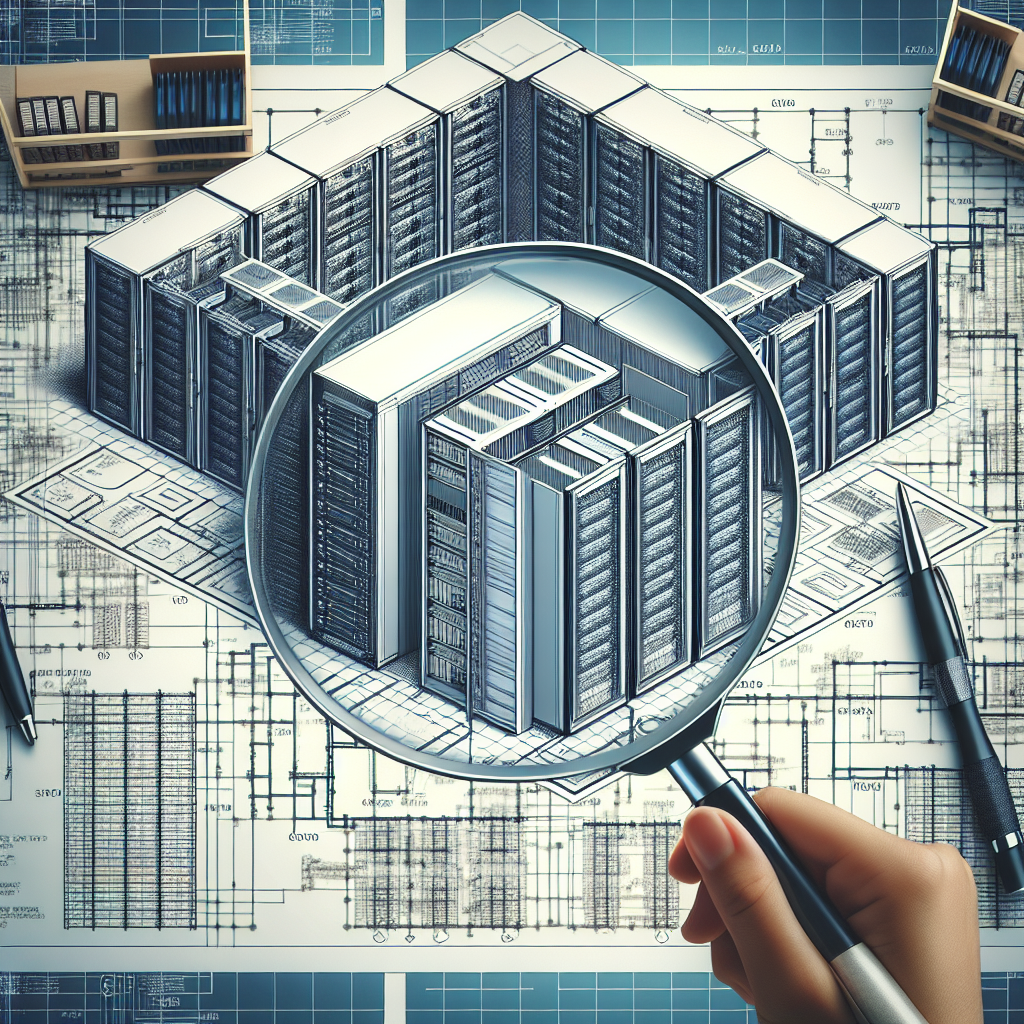Your cart is currently empty!
Tag: Growth

Future-proofing Data Center Electrical Systems for Growth and Scalability
In today’s fast-paced digital world, data centers are the backbone of organizations, supporting their critical operations and storing vast amounts of data. As businesses continue to grow and evolve, the demand for more powerful and efficient data center electrical systems is on the rise. To ensure that data centers can keep up with this increasing demand, it is crucial to future-proof their electrical systems for growth and scalability.One of the key considerations when future-proofing data center electrical systems is to design them with scalability in mind. This means building in the flexibility to easily add more capacity as needed, without having to overhaul the entire system. By incorporating modular components and scalable infrastructure, data centers can quickly adapt to changing requirements and accommodate future growth without causing disruptions to operations.
Another important aspect of future-proofing data center electrical systems is ensuring they are energy-efficient and sustainable. With the growing focus on environmental responsibility and the rising costs of energy, data centers need to prioritize efficiency in their electrical systems. This can be achieved through the use of energy-efficient equipment, smart power management systems, and renewable energy sources such as solar or wind power. By reducing energy consumption and minimizing their carbon footprint, data centers can lower operating costs and contribute to a more sustainable future.
In addition to scalability and energy efficiency, data center electrical systems must also be designed with reliability and redundancy in mind. Downtime can be costly for businesses, so it is essential to have backup power systems in place to ensure continuous operation in the event of a power outage. This can include uninterruptible power supply (UPS) systems, redundant power distribution units, and backup generators to provide a seamless transition during power disruptions.
Furthermore, as data centers continue to grow in size and complexity, it is important to consider the increasing power density requirements of modern IT equipment. High-density servers and storage systems can put a strain on traditional electrical systems, leading to overheating and performance issues. Future-proofing data center electrical systems involves implementing advanced cooling solutions, such as liquid cooling or hot aisle/cold aisle containment, to efficiently manage heat and maintain optimal operating conditions.
Overall, future-proofing data center electrical systems for growth and scalability is essential for organizations looking to stay ahead in today’s competitive business landscape. By designing systems with scalability, energy efficiency, reliability, and high power density in mind, data centers can ensure they are well-equipped to handle the demands of tomorrow’s digital world. Investing in advanced electrical infrastructure now will pay off in the long run, providing a solid foundation for continued growth and success in the future.

Understanding the Role of Data Center Capacity Planning in Business Growth
In today’s digital age, data centers play a crucial role in the success of businesses across various industries. As the amount of data generated and stored continues to grow exponentially, it has become increasingly important for organizations to effectively plan and manage their data center capacity. Capacity planning is the process of determining the computing resources required to support the current and future needs of a business. It involves analyzing the current usage of resources, predicting future growth, and making informed decisions about how to scale infrastructure to meet those needs.One of the key reasons why data center capacity planning is essential for business growth is that it helps organizations avoid costly downtime and performance issues. When a data center reaches its capacity limits, it can lead to slow response times, system crashes, and other issues that can disrupt business operations. By accurately forecasting future capacity requirements, businesses can proactively scale their infrastructure to accommodate growth and ensure that their systems are running smoothly at all times.
Capacity planning also helps businesses optimize their IT investments by identifying underutilized resources and reallocating them where they are needed most. By understanding which applications and workloads require the most resources, organizations can make more informed decisions about where to allocate their budget and resources. This can help businesses improve efficiency, reduce costs, and maximize the return on investment from their IT infrastructure.
Furthermore, capacity planning plays a critical role in ensuring business continuity and disaster recovery. By understanding their data center capacity requirements, organizations can develop robust disaster recovery plans that include provisions for scaling infrastructure in the event of a disaster or other unforeseen event. This can help businesses minimize downtime, protect critical data, and maintain operations during times of crisis.
In conclusion, data center capacity planning is a vital component of business growth and success in today’s digital world. By accurately forecasting capacity requirements, optimizing IT investments, and ensuring business continuity, organizations can scale their infrastructure to meet the demands of a rapidly evolving digital landscape. With the right capacity planning strategies in place, businesses can position themselves for long-term growth and success in the digital age.

Managing Scalability and Growth in Data Center IT Operations
In today’s fast-paced and highly competitive business environment, managing scalability and growth in data center IT operations is crucial for ensuring that organizations can keep up with the increasing demands of their customers and stakeholders. With the exponential growth of data being generated and processed every day, data centers must be equipped to handle this influx of information without compromising on performance or security.One of the key challenges in managing scalability and growth in data center IT operations is ensuring that the infrastructure can handle the increasing workload without experiencing any downtime or performance issues. This requires careful planning and regular monitoring of the data center environment to ensure that resources are being utilized effectively and efficiently.
To effectively manage scalability and growth in data center IT operations, organizations should consider implementing a few key strategies:
1. Virtualization: Virtualization technology allows organizations to consolidate their physical servers and storage devices into virtual machines, which can then be managed more efficiently and dynamically. This can help organizations scale their infrastructure as needed without having to invest in additional hardware.
2. Cloud Computing: Cloud computing offers organizations the flexibility to scale their IT infrastructure on-demand, allowing them to quickly ramp up resources during peak periods and scale down during slower times. This can help organizations save costs and improve overall efficiency.
3. Automation: Automation tools can help streamline IT operations and reduce the manual effort required to manage and scale the data center environment. By automating routine tasks such as provisioning, monitoring, and maintenance, organizations can free up their IT teams to focus on more strategic initiatives.
4. Scalable Networking: Ensuring that the data center network is scalable is essential for handling the increasing traffic and data volumes. Organizations should invest in scalable networking solutions that can accommodate growing bandwidth requirements and support high-speed connectivity.
5. Disaster Recovery Planning: In order to ensure business continuity and data protection, organizations should have a robust disaster recovery plan in place. This plan should include regular backups, data replication, and failover mechanisms to ensure that data can be recovered quickly in the event of a disruption.
Overall, managing scalability and growth in data center IT operations requires a proactive approach and a commitment to investing in the right technologies and strategies. By focusing on virtualization, cloud computing, automation, scalable networking, and disaster recovery planning, organizations can ensure that their data center infrastructure is equipped to handle the demands of today’s digital economy.

Driving Business Growth and Innovation Through Data Center Audits
In today’s fast-paced business environment, staying ahead of the competition requires a constant focus on driving growth and innovation. One often-overlooked aspect of this is the data center – the heart of any organization’s IT infrastructure. Data center audits are a critical tool for businesses looking to optimize their operations, improve efficiency, and drive business growth through innovation.What is a data center audit, and why is it important? Essentially, a data center audit is a comprehensive examination of an organization’s data center infrastructure, processes, and procedures. This includes everything from the physical layout of the data center to the security protocols in place to protect sensitive data. By conducting a thorough audit, businesses can identify areas for improvement, implement best practices, and ensure that their data center is operating at peak efficiency.
One of the key benefits of a data center audit is the ability to identify and address potential vulnerabilities in the data center infrastructure. In today’s digital age, the threat of cyber attacks is ever-present, and a single breach can have devastating consequences for a business. By conducting a thorough audit, organizations can identify weak points in their security measures and take steps to strengthen them, safeguarding their data and protecting their business from potential threats.
In addition to enhancing security, data center audits can also help businesses improve efficiency and reduce costs. By identifying areas where resources are being underutilized or where processes can be streamlined, organizations can optimize their data center operations and save money in the process. This can free up resources to invest in new technologies, expand operations, or pursue other growth opportunities.
Furthermore, data center audits can also drive innovation within an organization. By gaining a deeper understanding of their data center infrastructure and processes, businesses can identify opportunities for improvement, implement new technologies, and drive innovation. This can help businesses stay ahead of the competition, adapt to changing market conditions, and position themselves for long-term success.
In conclusion, data center audits are a critical tool for businesses looking to drive growth and innovation. By conducting a thorough examination of their data center infrastructure, processes, and procedures, organizations can identify vulnerabilities, improve efficiency, reduce costs, and drive innovation. In today’s competitive business environment, investing in a data center audit is a smart move for any organization looking to stay ahead of the curve and achieve long-term success.

Planning for Growth: Scaling Your Data Center with Capacity Planning
As businesses grow and expand, so too does the need for a robust and efficient data center. With the increasing reliance on data and technology in today’s world, it is more important than ever for organizations to adequately plan for the growth of their data center infrastructure. Capacity planning is a crucial aspect of this process, as it involves forecasting future demand and ensuring that the data center has the necessary resources to meet those requirements.Capacity planning involves assessing the current capacity of the data center, predicting future growth and demand, and making informed decisions about how to scale the infrastructure to accommodate this growth. By taking a proactive approach to capacity planning, organizations can avoid potential bottlenecks and downtime, optimize performance, and ensure that the data center remains efficient and cost-effective.
One key aspect of capacity planning is understanding the current utilization of resources within the data center. By monitoring key metrics such as CPU usage, memory usage, storage capacity, and network bandwidth, organizations can gain valuable insights into how resources are being utilized and identify potential areas for optimization. This information can then be used to forecast future demand and determine the necessary capacity requirements to support this growth.
Another important consideration in capacity planning is scalability. Organizations should design their data center infrastructure with scalability in mind, so that it can easily accommodate future growth without the need for extensive redesign or costly upgrades. This may involve implementing modular or scalable hardware solutions, virtualization technologies, and cloud services that can be easily scaled up or down as needed.
In addition to technical considerations, capacity planning also involves aligning the data center infrastructure with the organization’s business goals and objectives. By working closely with key stakeholders and understanding the organization’s future plans and growth projections, IT teams can develop a capacity plan that is closely aligned with the needs of the business.
Ultimately, capacity planning is an ongoing process that requires regular monitoring and adjustment to ensure that the data center remains in line with the organization’s evolving needs. By taking a proactive approach to capacity planning and investing in scalable and flexible infrastructure solutions, organizations can position themselves for growth and ensure that their data center remains a strategic asset that supports the success of the business.

The Role of Ventilation in Preventing Mold and Mildew Growth
Mold and mildew are common problems in homes, particularly in areas that are prone to high humidity levels. These fungi not only look unsightly but can also pose serious health risks to residents. One of the key factors that contribute to the growth of mold and mildew is poor ventilation. Inadequate ventilation can trap moisture in the air and create the perfect environment for mold and mildew to thrive.Ventilation plays a crucial role in preventing mold and mildew growth by promoting air circulation and reducing humidity levels. When air is allowed to circulate freely, it helps to remove excess moisture from the air, making it less likely for mold and mildew to develop. Proper ventilation can also help to prevent condensation from forming on surfaces, which can also contribute to mold growth.
There are several ways to improve ventilation in your home to prevent mold and mildew growth. One of the simplest and most effective ways is to open windows and doors regularly to allow fresh air to flow through your home. If you live in a particularly humid climate, using a dehumidifier can also help to reduce moisture levels in the air.
In areas such as bathrooms, kitchens, and basements where moisture levels tend to be higher, it is important to install ventilation fans to help remove excess moisture from the air. These fans should be used whenever these areas are in use, such as during showers or cooking, to help prevent mold and mildew growth.
Proper ventilation is also important in preventing mold and mildew growth in attics and crawl spaces. These areas are often neglected but can be breeding grounds for mold if they are not properly ventilated. Installing vents or fans in these spaces can help to promote air circulation and reduce moisture levels, preventing mold and mildew from taking hold.
In addition to improving ventilation, it is also important to address any existing mold or mildew problems in your home. This may involve cleaning and disinfecting affected areas, as well as addressing any underlying issues such as leaky pipes or roofs that may be contributing to moisture buildup.
In conclusion, ventilation plays a crucial role in preventing mold and mildew growth in homes. By promoting air circulation and reducing humidity levels, proper ventilation can help to create an environment that is less conducive to mold and mildew growth. Taking steps to improve ventilation in your home, along with addressing any existing mold problems, can help to ensure a healthy and mold-free living environment for you and your family.
